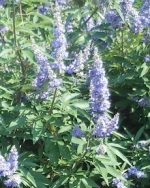 Also called monk’s pepper, chaste tree is a sprawling deciduous shrub and a member of the mint family, Lamiaceae, that also includes basil, deadnettle and ajuga. It is native to the Mediterranean region and western Asia where it grows in moist soil such as those along streams but after introduction to the US has become invasive in some areas from Pennsylvania and Oregon, south to Florida, Texas, and California. Plants grow 8-20’ tall and have palmately compound leaves with 5-7 lanceolate leaflets up to 6” long and are aromatic and grayish green. The small summer blooming flowers are lavender to light violet or white and are carried in loose panicles up to 12” long. They are fragrant and attract butterflies. Chaste tree has been grown in foundation plantings, shrub borders, cottage gardens and butterfly gardens, and as hedges and screens. In cold climates (Zones 5-6) the plants may die to the ground but send up shoots, grow vigorously, and bloom the next year. They are salt tolerant and drought tolerant once established. The genus name, Vitex, is derived from the Latin verb vieo meaning to weave and refers to the use of the plant in basketry. The specific epithet agnus-castus are the Latin words meaning lamb and chaste, respectively, and were the name of the plant in ancient time. Both the specific epithet and common name chaste tree refer to the belief that the plant was sacred to the virginal goddess Hestia/Vesta. The common name, monk’s pepper, alludes to the challenges of the vow of chastity by monks.
Also called monk’s pepper, chaste tree is a sprawling deciduous shrub and a member of the mint family, Lamiaceae, that also includes basil, deadnettle and ajuga. It is native to the Mediterranean region and western Asia where it grows in moist soil such as those along streams but after introduction to the US has become invasive in some areas from Pennsylvania and Oregon, south to Florida, Texas, and California. Plants grow 8-20’ tall and have palmately compound leaves with 5-7 lanceolate leaflets up to 6” long and are aromatic and grayish green. The small summer blooming flowers are lavender to light violet or white and are carried in loose panicles up to 12” long. They are fragrant and attract butterflies. Chaste tree has been grown in foundation plantings, shrub borders, cottage gardens and butterfly gardens, and as hedges and screens. In cold climates (Zones 5-6) the plants may die to the ground but send up shoots, grow vigorously, and bloom the next year. They are salt tolerant and drought tolerant once established. The genus name, Vitex, is derived from the Latin verb vieo meaning to weave and refers to the use of the plant in basketry. The specific epithet agnus-castus are the Latin words meaning lamb and chaste, respectively, and were the name of the plant in ancient time. Both the specific epithet and common name chaste tree refer to the belief that the plant was sacred to the virginal goddess Hestia/Vesta. The common name, monk’s pepper, alludes to the challenges of the vow of chastity by monks.
Type: Deciduous flowering shrub
Outstanding Feature: Flowers, foliage
Form: Vase-shaped
Growth Rate: Rapid
Bloom: Small lavender to white flowers in loose panicles up to 12” long in summer
Size: 8-20’ H x 5-8” W
Light: Full sun
Soil: Average, medium moist, well-drained; tolerates drought once established.
Hardiness: Zones 6-9
Care: Deadhead to encourage continuous bloom. Flowering is on new growth so plants can be pruned in the early spring.
Pests and Diseases: Thrips, leaf spot, root root,
Propagation: Seed, cuttings in summer or winter, layering
Comments: May become invasive especially in the South.